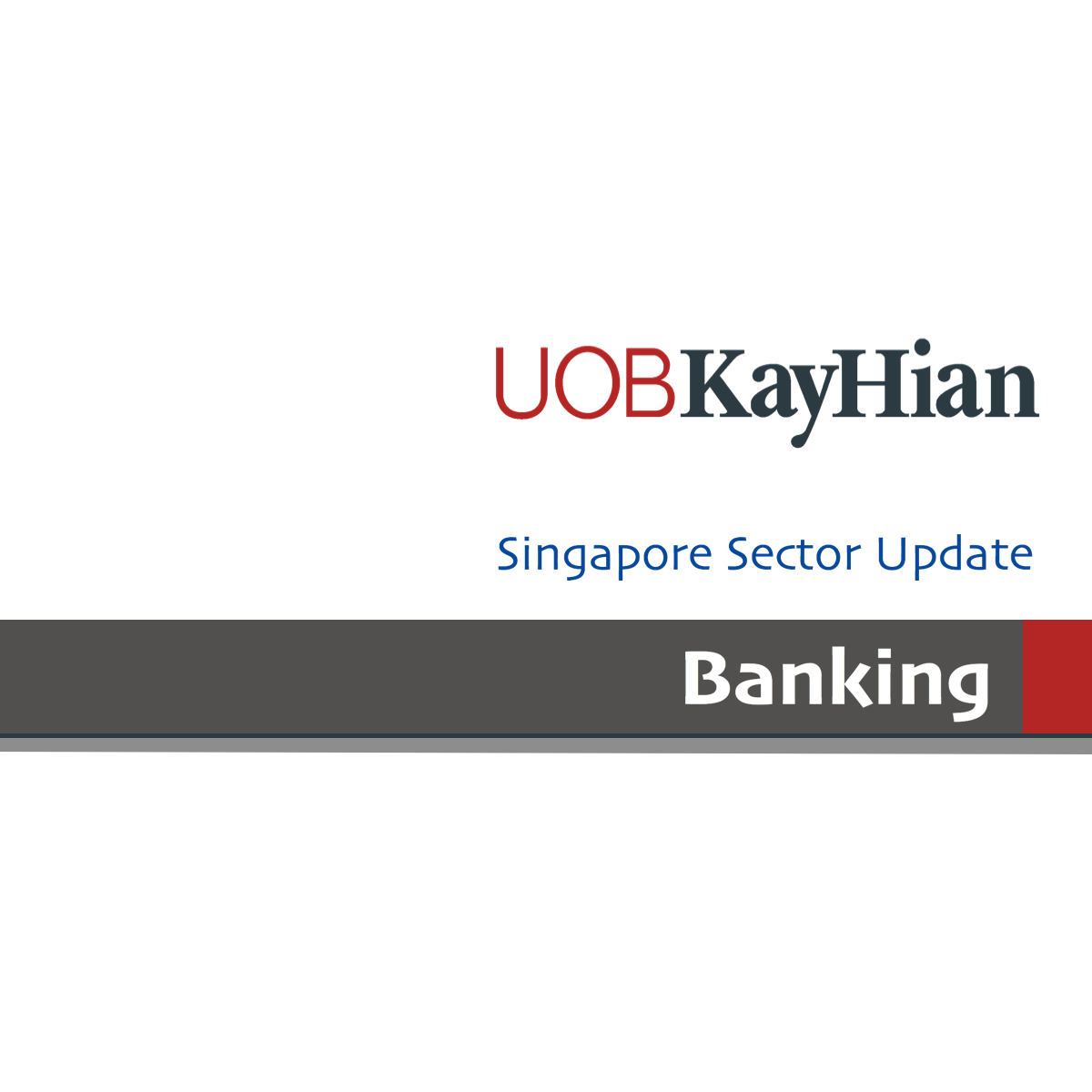 Singapore Banking Stocks
DBS vs OCBC vs UOB
DBS GROUP HOLDINGS LTD
D05.SI
OVERSEA-CHINESE BANKING CORP
O39.SI
UNITED OVERSEAS BANK LTD
U11.SI
Singapore Banking Stocks
DBS vs OCBC vs UOB
DBS GROUP HOLDINGS LTD
D05.SI
OVERSEA-CHINESE BANKING CORP
O39.SI
UNITED OVERSEAS BANK LTD
U11.SI
Banking – Singapore - Assessing Productivity And Cost Efficiency
- OCBC leads in cost efficiency with the lowest staff cost per employee at S$83,333. Its other non-wage expenses are also very lean.
- DBS leads in productivity with the highest income per employee at S$538,805 and PPoP per employee at S$313,701. However, OCBC and UOB are fast catching up in productivity.
- Maintain OVERWEIGHT. BUY OCBC and DBS. Prefer OCBC, followed by DBS.
WHAT’S NEW
- Investments in fintech have accelerated on a global basis since 2014. In this report, we assesses if productivity and cost efficiency have improved and try to identify key drivers.
Headcount.
- DBS has the smallest workforce at 23,114 despite:
- the acquisition of Societe Generale’s private banking businesses in Singapore and Hong Kong in 4Q14 and ANZ’s wealth management and retail banking businesses in 3Q17, and
- increase in headcount of 484 in 2016 and 1,154 in 9M17 due to insourcing of IT.
- Conversely, OCBC had the largest headcount of 29,161 as of Sep 17. Its headcount grew 14% after it consolidated Wing Hang Bank in 3Q14.
- UOB has kept headcount relatively unchanged as it maintains a ASEAN-centric footprint and did not partake in any major M&As.
Income per employee.
- DBS had the most productive workforce with income per employee at S$538,805 as of 3Q17 (annualised), significantly above the S$323,465 for OCBC and S$361,289. DBS benefits from economies of scale due to its established presence in Singapore and Hong Kong with market shares estimated at 20.6% and 5% respectively.
- OCBC’s income per employee stayed flat in 2015 and 2016, possibly held back by the integration of Wing Hang Bank, but had improved 11% ytd in 9M17.
- UOB’s income per employee has grown steadily at an average of 2.3% annually.
Staff cost per employee.
- DBS’ staff cost per employee is higher at S$120,830, vs S$83,333 for OCBC and S$87,620 for UOB. However, DBS’ staff cost per employee grew at a slightly slower CAGR at 3.6% for 2013-17, vs 4.8% for OCBC and 4.9% for UOB.
- Staff cost accounted for 56% of operating expenses for DBS, vs 61.6% for OCBC and 55.3% for UOB in 9M17.
PPoP per employee.
- DBS has the highest PPoP per employee at S$313,701, vs S$182,703 for OCBC and S$204,284 for UOB.
- OCBC and UOB registered faster growth with PPoP per employee growing at for 2013-17 CAGR of 4.4% and 4.9% respectively, vs 2.1% for DBS.
ACTION
Maintain OVERWEIGHT.
- The normalisation of central banks’ balance sheets coupled with resilient global growth could energise banks’ share prices and lift their valuations towards and above their mid-cycle valuations.
- Deregulation for banks and efforts towards reducing the corporate tax rate in the US also add to the positive sentiments.
DBS Group Holdings (BUY/S$25.30/Target: S$26.10)
- DBS grew total income at a faster 6.4% yoy in 2016 and 1.8% yoy in 9M17 (-2.2% if we exclude gains of S$350m from the divestment of PwC Building), compared with 1.5% and 0.6% for expenses respectively. The positive JAWS enabled DBS to register a 1.5ppt improvement in cost-to-income ratio (CIR) to 43.3% for 2016. CIR deteriorated by 1ppt to 44.3% in 9M17 if we adjust for gains from the divestment of PwC Building.
- DBS owns and run its own technology IT infrastructure for greater control and flexibility.
- Insourcing has increased from 15% in 2009 (outsource: 85%) to 85% in 2017 (outsource: 15%). IT expenses dropped 0.7% yoy in 2016 and 8.9% yoy in 9M17 after completing digital transformation and launching DigiBank in India in Apr 16.
- Our target price of S$26.10 is based on 1.38x 2018F P/B, derived from the Gordon Growth Model (ROE: 10.5%, COE: 8.0% (Beta: 1.1x) and Growth: 1.5%).
Oversea-Chinese Banking Corp (BUY/S$12.59/Target: S$13.56)
- OCBC consolidated Wing Hang Bank in 3Q14. It managed to maintain CIR at 42% in 2015 despite the initial drag from OCBC Wing Hang, which had a higher CIR of 48.4%.
- OCBC NISP achieved the most significant improvement in CIR of 11.4ppt from 55.5% in 2014 to 44.1% in 9M17. OCBC has a lean cost structure. Other non-wage expenses accounted for 38.4% of total operating expenses.
- CIR deteriorated in 2016 but vastly improved in 9M17. Wealth management and life insurance fared badly in 2016 but recovered significantly in 9M17. It also trimmed headcount by 2.1% in 9M17. OCBC had the lowest CIR of 42.3% in 9M17.
- Our target price of S$13.56 is based on 1.44x 2018F P/B, derived from the Gordon Growth Model (ROE: 10.5%, COE: 7.75% (Beta: 1.05x) and Growth: 1.5%).
United Overseas Bank (NOT RATED/S$26.79)
- Expenses grew faster than income in 2015 and 2016, resulting in deterioration in CIR.
- Growth in income picked up to 8.5% yoy in 9M17 but expense growth of 6.7% was still faster than peers (DBS: +0.6%, OCBC: +5.7%).
- IT expenses grew at a 3-year CAGR of 21.4% in 2014-16. IT expenses accounted for 9% of operating expenses in 9M17, vs 17% for DBS.
SECTOR CATALYSTS
- Rising interest rates and bond yields.
- Easing of pressure on asset quality from the oil & gas sector.
ASSUMPTION CHANGES
- We maintain our existing earnings forecasts.
RISKS
- Rapid increase in the federal funds target rate (steep rate hikes) that may trigger capital outflows from countries in Southeast Asia.

Jonathan Koh CFA
UOB Kay Hian
|
http://research.uobkayhian.com/
2017-12-14
UOB Kay Hian
SGX Stock
Analyst Report
26.100
Same
26.100
13.560
Same
13.560
99998.000
Same
99998.000

